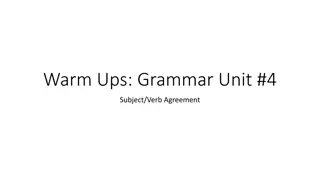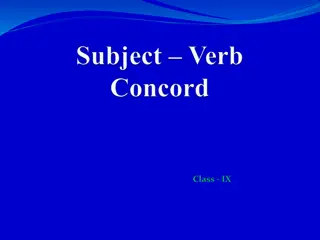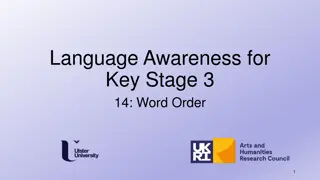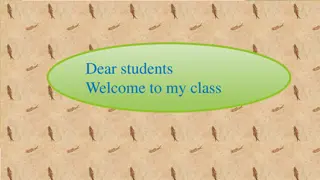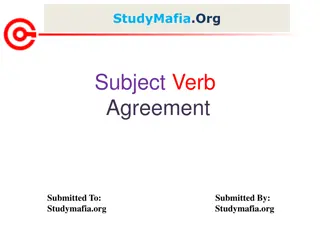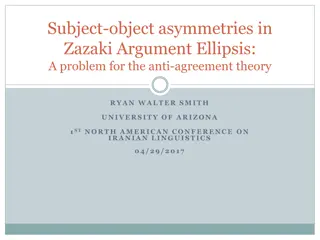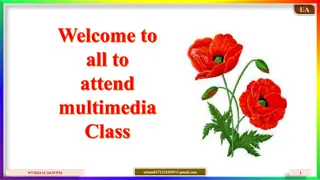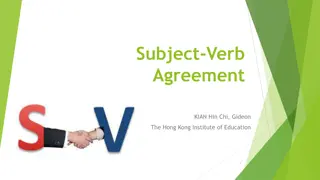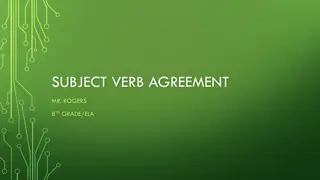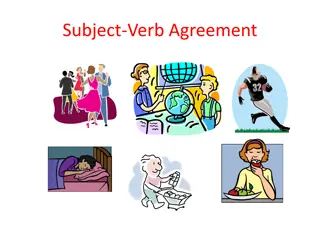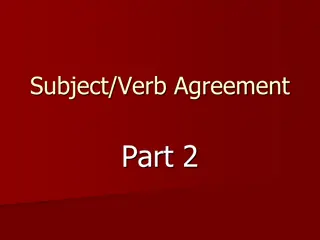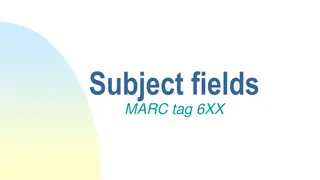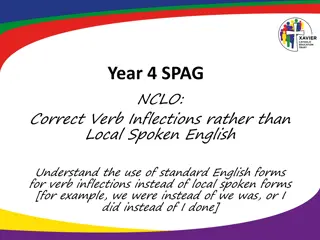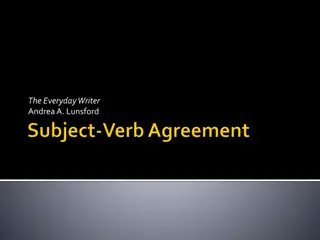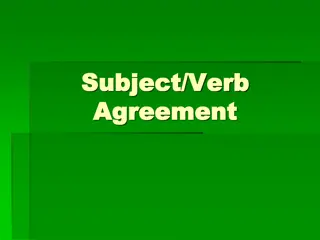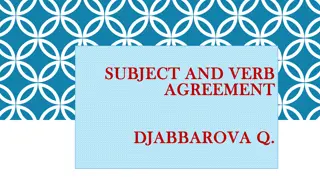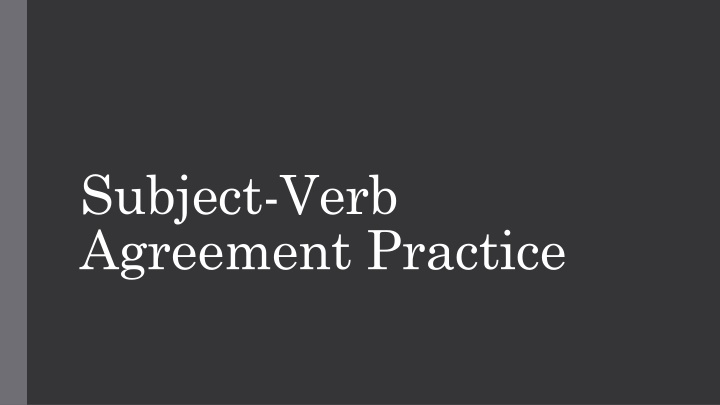
Subject-Verb Agreement Practice and Rules
"Enhance your understanding of subject-verb agreement through clear explanations and examples. Learn the basic principles and rules for ensuring subject-verb agreement in sentences, including exceptions and cautions. Explore how contractions, interrupting phrases, indefinite pronouns, collective nouns, and tricky nouns can impact agreement. Master the usage of singular and plural verbs with different subject scenarios."
Uploaded on | 2 Views
Download Presentation

Please find below an Image/Link to download the presentation.
The content on the website is provided AS IS for your information and personal use only. It may not be sold, licensed, or shared on other websites without obtaining consent from the author. If you encounter any issues during the download, it is possible that the publisher has removed the file from their server.
You are allowed to download the files provided on this website for personal or commercial use, subject to the condition that they are used lawfully. All files are the property of their respective owners.
The content on the website is provided AS IS for your information and personal use only. It may not be sold, licensed, or shared on other websites without obtaining consent from the author.
E N D
Presentation Transcript
Subject-Verb Agreement Practice
The Basic Principle: A subject must agree with its verb(s). Singular subjects must have singular verbs. Plural subjects must have plural verbs. In other words, subjects and verbs must match.
The Rules 1. When the subject of a sentence is composed of two or more nouns or pronouns connected by and, use a plural verb. Ender, Valentine, and Peter are siblings. (Plural)
The Rules 2. When two or more singular nouns or pronouns are connected by or or nor, use a singular verb. Neither Valentine nor Peterwas selected for Battle School. (Singular)
The Rules 3. When a compound subject contains both a singular and a plural noun or pronoun joined by or or nor, the verb should agree with the part of the subject that is nearer the verb. Neither Ender s teacher nor his siblingsbelieve he will be chosen to attend Battle School. (Plural) Neither Valentine nor Peterwas selected for Battle School. (Singular)
Neither/nor and Either/or For sentences containing neither/nor or either/or, a helpful hint is to cover up everything in the sentence prior to the nor or or. Then, determine if a singular or plural verb is needed. Neither Valentine nor Peterwas selected for Battle School. (Singular) Neither Ender s teacher nor his siblingsbelieve he will be chosen to attend Battle School. (Plural)
Cautions Contractions Interrupting phrases Indefinite pronouns Collective nouns Tricky nouns There
Contractions Doesn t Singular Ender doesn t know how special he is. Don t Plural The Launchies don t realize how clever Ender is. Exceptions The singular pronouns I and you always use don t or do not. I don t know if I would be willing to leave my family to attend Battle School. You don t understand why it is imperative that Ender attends Battle School.
Interrupting Phrases Watch out for phrases that come between the subject and verb. Families with the exception of Ender s family are not allowed to have more than two children. Andrew Wiggins, the younger brother of Valentine and Peter, ischosen to attend Battle School. Some bulliesat Ender s school tease him about being a Third. One of the bullies at school isa lot like Ender s brother, Peter. Stilson s friends at the request of Stilson who is convinced by Ender do not join in the fight. Ender without his monitor and its protection worries his brother may kill him.
Indefinite Pronouns Always Singular each Always Plural both several few many all everyone someone anybody neither somebody Eachis allowed two children. Allmust comply with this law. Nobodyexcept Ender s family is exempt from it. Nothingcan be done without the government s permission. Everybodyis expected to obey. Manyarejealous of Ender s intelligence. either nobody nothing everybody anything one everything anyone something
Collective Nouns Acting Individually - Plural Acting Together as One - Singular The classlook at their desks, ask each other questions, and glance at Ender. The classis astonished. The army plans its next battle. The army guard the goal, defend the offense, and spread themselves. Tip: Try substituting different nouns to check plural verbs. Reread the above sentences substituting students for class and soldiers for army.
Tricky Nouns Plural Singular One object with two parts One object that ends in s Scissors Civics Tweezers Mathematics Pants Measles Trousers News
There Sentences beginning with there are inverted: the subject follows the verb. There is not the subject of the sentence. There is only one child like Ender. There are no others like Ender.
Lets Practice. The following exercises can be used as bell ringers.
Practice 1: Match the verb to its sentence. And there _____ doubts about him. A. are 1. But there ll be some tickling, and some people _____ they have a feeling of something missing. B. is 2. C. say D. says Not if the other person _____ his enemy. 3. E. was Some _____ dumping lessons or data into their computers at home. 4. F. were It _____ upside down and backward at first, but Ender knew what it said long before it reached the bottom of his desk and turned right side up. 5.
Practice 2: Identify whether the subjects and verbs are singular or plural. 1. And there are doubts about him. 2. But there ll be some tickling, and some people say they have a feeling of something missing. 3. Not if the other person is his enemy. 4. Some were dumping lessons or data into their computers at home. 5. It was upside down and backward at first, but Ender knew what it said long before it reached the bottom of his desk and turned right side up.
Practice 3: Match the verb to its sentence. 1. Anything I _____ will make it worse. A. are 2 & 3. They __2___ all wondering if he __3___ B. is C. say dead. D. says 4. There _____ a Band-Aid. E. was 5. This ____ all right, Ender thought. F. were 6. Now, they _____n t checking to see if you feel pain, listening to hear what I m saying what I m doing to you. How about that? How about it?
Practice 4: Identify whether the subjects and verbs are singular or plural. 1. Anything I say will make it worse. 2 & 3. They were all wondering if he was dead. 4. There is a Band-Aid. 5. This is all right, Ender thought. 6. Now, they aren t checking to see if you feel pain, listening to hear what I m saying what I m doing to you. How about that? How about it?
Practice 5: Unscramble the Sentence Parts out entitled Andrew Wiggin after all hadn t worked the experiment Identify the subject and verb. Are they singular or plural?
Practice 6: Identification Sentence Parts Identify each sentence part. 1. out Adv - Adverb 2. entitled Andrew Wiggin C - Conjunction 3. after all I Infinitive Phrase 4. hadn t worked Part Participial Phrase 5. the experiment S Subject V- Verb or verb phrase Prep Prepositional Phrase
Practice 7: Imitate the following sentence. The experiment entitled Andrew Wiggin hadn t worked out after all. Be sure that your subject and verb agree.
Practice 8: Identify whether the subjects and verbs are singular or plural. 1. This will not have a happy ending. 2. For a moment, the others backed away, and Stilson lay motionless. 3. Ender knew the unspoken rules of manly warfare, even though he was only six. 4. You might be having some idea of ganging up on me. You could probably beat me up pretty bad. 5. Nobody followed him.
Practice 9: Unscramble the Sentence Parts in three dimensions Ender on his desk to display them drawing contour maps doodled and of mountainous islands then telling his desk from every angle Identify the subject and verb. Are they singular or plural?
Practice 10: Identification Sentence Parts Identify each sentence part. in three dimensions 1. Adv - Adverb on his desk 2. C - Conjunction drawing contour maps 3. and 4. I Infinitive Phrase telling his desk 5. Part Participial Phrase Ender 6. S Subject doodled 7. V- Verb to display them 8. Prep Prepositional Phrase of mountainous islands 9. 10. from every angle 11. then
Practice 11: Imitate the following sentence. Ender doodled in three dimensions on his desk, drawing contour maps of mountainous islands and then telling his desk to display them from every angle. Be sure that your subject and verb agree.

